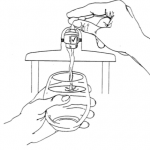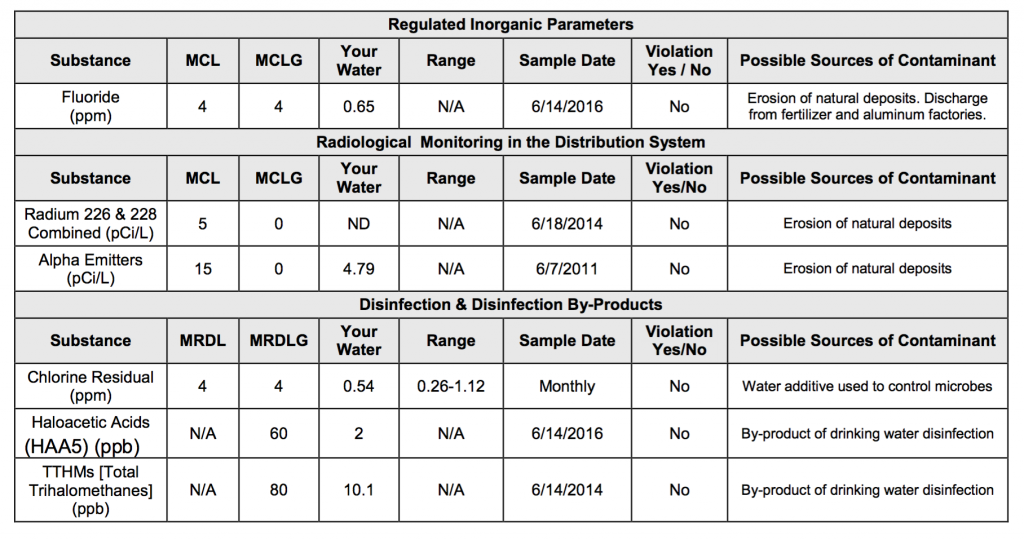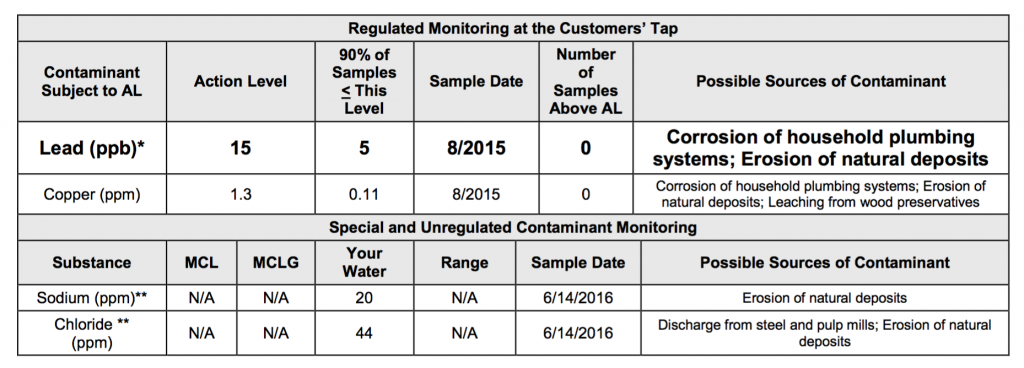Public Notice: 2016 Water Quality Report for The Village of Manchester
This report covers the drinking water quality for the Village of Manchester for the 2016 calendar year. This information is a snapshot of the quality of the water that we provided to you in 2016. Included are details about where your water comes from, what it contains, and how it compares to Environmental Protection Agency (EPA) and state standards.
Your water comes from three groundwater wells, each over 85 feet deep. The State performed an assessment of our source water to determine the susceptibility or the relative potential of contamination. The susceptibility rating is on a seven-tiered scale from "very-low" to "very- high" based on geologic sensitivity, well construction, water chemistry, and contamination sources. The susceptibility of our source is moderately high based on geological sensitivity analysis of the groundwater aquifer. This aquifer is characterized as “leaky confined”.
Potential sources of contamination include leaking underground storage tank sites in our water supply area. The Village of Manchester strives to provide our residents with the highest quality water. We are making efforts to protect our sources by participation in a Wellhead Protection Program.
If you would like to know more about this report, please contact the Village of Manchester Water Department at 734-428-7171.
• Contaminants and their presence in water: Drinking Water, including bottled water, may reasonably be expected to contain at least small amounts of some contaminants. The presence of contaminants does not necessarily indicate that water poses a health risk. More information about contaminants and potential health effects can be obtained by calling the EPA’s Safe Drinking Water Hotline (800-426-4791).
• Vulnerability of sub-populations: Some people may be more vulnerable to contaminants in drinking water than the general population. Immuno- compromised persons such as persons with cancer undergoing chemotherapy, persons who have undergone organ transplants, people with HIV/AIDS or other immune systems disorders, some elderly, and infants can be particularly at risk from infections. These people should seek advice about drinking water from their health care providers. EPA/CDC guidelines on appropriate means to lessen the risk of infection by Cryptosporidium and other microbial contaminants are available from the Safe Drinking Water Hotline (800-426-4791).
- Sources of drinking water: The sources of drinking water (both tap water and bottled water) include rivers, lakes, streams, ponds, reservoirs, springs, and wells. Our water comes from wells. As water travels over the surface of the land or through the ground, it dissolves naturally-occurring minerals and, in some cases, radioactive material, and can pick up substances resulting from the presence of animals or from human activity.
- Contaminants that may be present in source water include:
- Microbial contaminants, such as viruses and bacteria, which may come from sewage treatment plants, septic systems, agricultural livestock operations and wildlife.
- Inorganic contaminants, such as salts and metals, which can be naturally-occurring or result from urban stormwater runoff, industrial or domestic wastewater discharges, oil and gas production, mining or farming.
- Pesticides and herbicides, which may come from a variety of sources such as agriculture, urban stormwater runoff, and residential uses.
- Radioactive contaminants, which are naturally occurring or be the result of oil and gas production and mining activities.
- Organic chemical contaminants, including synthetic and volatile organic chemicals, which are by-products of industrial processes and petroleum production, and can also come from gas stations, urban stormwater runoff, and septic systems.
In order to ensure that tap water is safe to drink, EPA prescribes regulations that limit the amount of certain contaminants in water provided by public water systems. Food and Drug Administration regulations establish limits for contaminants in bottled water which provide the same protection for public health.

Water Quality Data
The table below lists all the drinking water contaminants that we detected during the 2016 calendar year. The presence of these contaminants in the water does not necessarily indicate that the water poses a health risk. Unless otherwise noted, the data presented in this table is from testing done January 1 – December 31, 2016. The State allows us to monitor for certain contaminants less than once per year because the concentrations of these contaminants are not expected to vary significantly from year to year. All of the data are representative of the water quality, but some are more than one year old.
Terms and abbreviations used below:
- Maximum Contaminant Level Goal (MCLG): The level of a contaminant in drinking water below which there is no known or expected risk to health. MCLGs allow for a margin of safety.
- Maximum Contaminant Level (MCL): The highest level of a contaminant that is allowed in drinking water. MCLs are set as close to the MCLGs as feasible using the best available treatment technology.
- Maximum residual disinfectant level goal (MRDLG): The level of a drinking water disinfectant below which there is no known or expected risk to health. MRDLGs do not reflect the benefits of the use of disinfectants to control microbial contaminants.
- Maximum residual disinfectant level (MRDL): The highest level of a disinfectant allowed in drinking water. There is convincing evidence that addition of a disinfectant is necessary for control of microbial contaminants.
- N/A: Not applicable
- ND: not detectable at testing limit
- ppb: parts per billion or micrograms per liter
- ppm: parts per million or milligrams per liter
- pCi/L: picocuries per liter (a measure of radioactivity).
- Action Level: The concentration of a contaminant which, if exceeded, triggers treatment or other requirements that a water system must follow.


* If present, elevated levels of lead can cause serious health problems, especially for pregnant women and young children. Lead in drinking water is primarily from materials and components associated with service lines and home plumbing. The Village of Manchester is responsible for providing high quality drinking water, but cannot control the variety of materials used in plumbing components. When your water has been sitting for several hours, you can minimize the potential for lead exposure by flushing your tap for 30 seconds to 2 minutes before using water for drinking or cooking. If you are concerned about lead in your water, you may wish to have your water tested. Information on lead in drinking water, testing methods, and steps you can take to minimize exposure is available from the Safe Drinking Water Hotline or at http://www.epa.gov/safewater/lead.
** Unregulated contaminants are those for which EPA has not established drinking water standards. Monitoring helps EPA to determine where certain contaminants occur and whether it needs to regulate those contaminants.
We will update this report annually and will keep you informed of any problems that may occur throughout the year, as they happen. Copies are available at the Manchester Village Hall. This report will not be sent to you.
We invite public participation in decisions that affect drinking water quality. The Manchester Village Council meets the first and third Monday of each month at 7:00 PM at the Manchester Village Hall if you would like to attend a meeting. For more information about your water, or the contents of this report, contact Daniel Geyer at 734-428-7171. For more information about safe drinking water, visit the U.S. Environmental Protection Agency at www.epa.gov/safewater/.








You must be logged in to post a comment Login